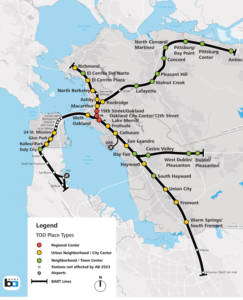An Unprecedented Urban Development Opportunity – By Jeffrey J. Crosswhite
By Hoge Fenton | 10.4.2022 | Firm Post

An Unprecedented Urban Development Opportunity:
SF Bay Area Cities Miss the State Deadline to Rezone BART Properties for Housing
By Jeffrey J. Crosswhite
The Bay Area Rapid Transit Authority (BART) just became a major player in the urban housing development market.
On July 1, 2022, under California State bill AB 2923, the deadline expired for Bay Area cities and counties to adopt new zoning laws that would establish the right to build affordable housing mixed-use developments on large BART-owned properties in their jurisdiction. AB 2923 provided these cities with an ultimatum: if you don’t make this happen in four years, BART will for you. On July 1st of this year, numerous cities and counties failed to meet that deadline.
Cities and Counties in Default under AB 2923
On August 25, 2022, the BART Board of Directors adopted its staff Summary of Conformance Findings, finding that, except for the cities of Berkeley and San Leandro, every Bay Area city failed to rezone one or more BART parcels in its jurisdiction to comply with each of the minimum zoning standards imposed by AB 2923 (e.g., housing density, affordability, floor-area-ratio, and building height), thus resulting in reversion to BART’s zoning standards in one or more of those categories.
The following cities and counties forfeited their residential density zoning authority to BART as to one or more BART parcels located in their jurisdiction:
|
 |
What Happens Now?
The text of AB 2923 indicates the legislature’s ultimatum, though well-intentioned, was only half-baked, and did not anticipate Bay Area cities to continue to delay housing development. It is rare in urban planning, if not unprecedented, to remove local planning authority and grant it to a regional government-owned metro rail agency. This suggests AB 2923 is vulnerable to constitutional challenges by cities. Further, between the newly-minted AB 2923 and BART’s pre-existing mandates, the law is far from clear as to how the spirit of AB 2923 will be implemented in these defaulted cities. What is the application process? What zoning designations, development standards, and building codes apply? Who grants the development entitlement? These questions present a “grey area” and a unique development opportunity for BART properties in those jurisdictions.
Key Features of the BART Housing Development Process under AB 2923
- Minimum housing density will be 75 units per acre (75 DU/AC) with 20% being affordable
- Local planning agencies will continue processing applications
- Developers may enter an Exclusive Negotiating Agreement with BART
- Streamlined project opportunities and CEQA exemptions depending on affordable housing components
What is the Current Zoning Standard for BART Properties in those Cities and Counties that Failed to meet the Deadline under AB 2923?
Under AB 2923 (codified as Pub. Util. Code, § 29010.6), the BART TOD Guidelines (2017) were codified as baseline standards for the “minimum allowable density and height limits, and the highest allowable parking limits” unless BART modified those baseline standards by July 1, 2020, or a local jurisdiction exceeded each of BART’s baseline standards. 1 2 Neither of those things happened. As a result, under Pub. Util. Code, § 29010.6, the 2017 BART TOD Guidelines supplanted local zoning standards for BART-parcels in jurisdictions that failed to timely exceed those standards. Those 2017 BART TOD Guidelines state, “TOD projects on BART land will meet a minimum net residential density standard of 75 units per acre” of which twenty percent (20%) will need to be affordable units. 3
Developers Should Take a Two-Pronged Approach to Development Applications
Developers of eligible BART properties should prepare to work with both BART and local planning jurisdictions. BART is not directly approving projects. AB 2923 grants BART no direct project approval authority, only legislative authority to adopt TOD standards, the power to determine whether a local city or county’s zoning and development standards conform to its TOD standards, and the power to enter into development agreements with developers of its property. 4 5 6 Notwithstanding any additional approval authority BART may delegate to a local planning jurisdiction, a local planning jurisdiction retains some approval power subject to BART’s TOD zoning standards, but also its own existing zoning standards that do not contradict the BART TOD zoning standards.
In sum, AB 2923 limits a local planning jurisdiction’s legislative and adjudicative discretion over BART parcel developments but does not eliminate it. Therefore, developers will not be able to obtain project approval from BART alone and should be prepared to work with the local city, county, and local stakeholders to obtain project approvals.
Streamline Application Eligibility under AB 2923
Obtaining approval for the development of a BART parcel under AB 2923 will likely not be a rubber-stamp process. However, a streamlined process is achievable, so long as the following conditions are met:
1. the developer is selected by BART (with city/county input) to enter into an exclusive negotiating agreement; and
2. the project complies with the applicable TOD standards (75 DU/AC, 20% affordable, height, FAR, parking).
Under AB 2923 (as codified in Pub. Util. Code, § 29010.7(b)(1)), “a developer in an exclusive negotiating agreement with BART may submit an application for a development that is subject to the streamlined, ministerial approval process not subject to a conditional use permit as specified in Section 65913.4 of the Government Code.” This means a TOD developer selected by BART to enter an ENA will be eligible for the streamlined process and exempt from local discretionary conditional use permit conditions provided under the low-income housing statute, Section 65913.4 of the Government Code (also known as Senate Bill 35).
Uncertainty Provides Opportunity
Now is the time to explore development opportunities on BART parcels located in defaulted planning jurisdictions. Presently, BART and these defaulted Bay Area cities and counties are still grappling with how to implement BART’s TOD Standards and AB 2923. The default BART TOD 2017 density and affordability standards are the minimum, but those standards are likely to increase in complexity over time as local planning agencies gain their footing under the new rules. Furthermore, BART is likely to provide ample leeway to local authorities to adopt their own rules so that BART doesn’t have to do the work. To that end, AB 2923 provides a backdoor for local jurisdictions that failed to comply with the July 1, 2022 deadline: the law suggests defaulting cities may still adopt development standards so long as BART has not entered into an exclusive negotiating agreement (“ENA”) with a developer under the previous standards. 7 BART’s Technical Guidance suggests it has no interest in processing development applications and would prefer the established local planning agencies take the reins. Developers may be wise to get their foot in the door before the rules change. On the other hand, the current lack of certainty in the entitlements process between two agencies (and CEQA implications) might prove infeasible.
1 Pub. Util. Code, § 29010.6 (“The zoning standards published in Table 1 and Figure 1 of the BART TOD Guidelines (2017) shall serve as the minimum allowable density and height limits, and the highest allowable parking limits to which the board is required to adhere in adopting TOD zoning standards.”)
2 Pub. Util. Code, § 29010.6(d)(1)(“Where local zoning is inconsistent with the TOD zoning standards for a station, the local jurisdiction shall adopt a local zoning ordinance that conforms to the TOD zoning standards and is operative within two years of the date that the TOD zoning standards are adopted by the board for a station, or by July 1, 2022, if the board has not adopted TOD zoning standards for the station.”)
3 2017 BART TOD Guidelines, pp. 9, 16,
4 Legislative Counsel’s Digest, AB 2923 (“The bill would require BART to ensure any otherwise applicable local design standards are included as general guidance to the TOD developer and would require a TOD developer to adhere to any applicable local design standards insofar as those standards do not prohibit the minimum height, minimum density, minimum floor area ratio, and maximum parking allowances required by the TOD zoning standards.”)
5 Pub. Util. Code, § 29010.7(d)(1) (“The district shall ensure any otherwise applicable local design standards, insofar as those standards do not prohibit the minimum height, minimum density, minimum floor area ratio, and maximum parking allowances required by the TOD zoning standards, are included as general guidance to the TOD developer. (2) A TOD developer shall adhere to any applicable local design standards insofar as those standards do not prohibit the minimum height, minimum density, minimum floor area ratio, and maximum parking allowances required by the TOD zoning standards.”)
6 Pub. Util. Code, § 29036 (“The board of directors shall refer for the recommendation the plans of routes, rights of way, terminals, stations, yards, and related facilities and improvements to the city councils and boards of supervisors within whose jurisdiction said facilities and improvements lie and to such other state, regional and local agencies and commissions as may be deemed appropriate by the board of directors. The board of directors shall give due consideration to all recommendations submitted.”)
7 Pub. Util. Code, § 29010.6 (“For each station, a local jurisdiction may update zoning for district-owned land to comply with TOD zoning standards until the time that the district enters into an exclusive negotiating agreement with a developer for an eligible TOD project.”)
 |
Jeffrey Crosswhite is an Attorney in the Real Estate practice group of Hoge Fenton. He advises businesses, utilities, developers, property owners, and entrepreneurs throughout California and Oregon in land use, business transactions, and litigation matters.
Hoge Fenton is a full-service law firm that knows the Bay Area real estate development market and is involved in many land use projects and real estate development projects in the Bay Area. Our attorneys have deep experience and local knowledge in the Northern California public and private real estate arena. |
This article is provided as an educational service by Hoge Fenton. The information discussed is an overview only and should not be construed as legal advice or advice to take any specific action. Please be sure to consult a knowledgeable professional for assistance with your particular legal issue. © 2022 Hoge Fenton








